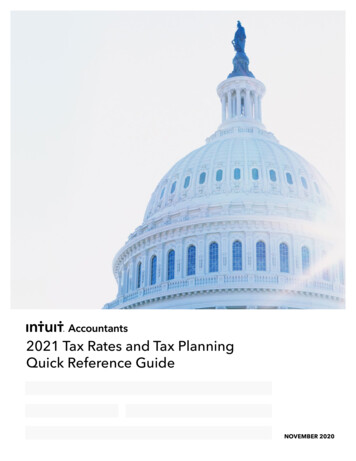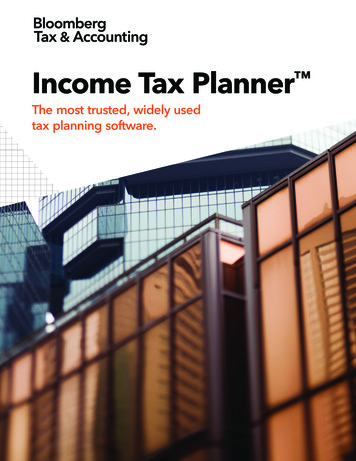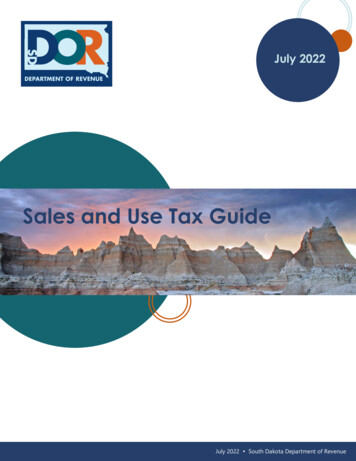
Transcription
Tax Planning Issuesfor 2017:20 IdeasLeon C. LaBrecque, JD, CPA, CFP , CFALJPR Financial Advisors5480 Corporate Drive, Suite 100 Troy, Michigan 48098Phone: 248.641.7400 Fax: 248.641.7405Email: leon.labrecque@ljpr.comTwitter: ember 13, 2017
The proposed GOP Tax Cuts and Jobs Act (TCJA) is very farreaching and sweeping in tax changes. While there is no wayto predict where it will go, there are some planning moves thatpeople can consider before the end of 2017. Here’s a short-listof planning opportunities (and possible pitfalls):Charity4.The TCJA raises the standard deduction, so going forwardtaxpayers will need more itemized deductions to receive the taxbenefit of excess deductions, including charity.If you itemize:1.2.3.5.Make additional contributions before year-end –consider pulling 2018’s donations into this year instead.Every additional dollar is likely saved at your currentrate, which is most likely to be lower next year.Donate appreciated property like stocks or mutualfunds. A high stock market like the one we are currentlyexperiencing provides an additional opportunity. Givingappreciated investments avoids capital gains tax andpossibly the additional net investment income taxand allows a fair market value deduction. There is alimitation of 50% of your Adjusted Gross Income (AGI),but you can carry-over the unused portion to futureyears (when the limitation goes up to 60% of AGI). Ifyou are considering gifting mutual funds, do so beforethe funds declare their capital gains and dividends.You’ll save taxes by not recognizing that income as well.Use a Donor Advised Fund (DAF) or CommunityFoundation (CF) to max out contributions if you areunsure of where to contribute. If you give 50,000 toa DAF, you deduct it all now, but can designate yourcharities over time. You can even invest the undonatedportion of your DAF so there is more to donate in thefuture.Clean out your closet and your garage, and give theextra stuff to charity. Ask the charity for a receipt andkeep a thorough list of what you donated, includingvalues. Use garage sale or thrift store prices to assignfair market values to the items you donate. You coulduse a valuation program like ItsDeductible to figure outthe value (itsdeductible.com).If you have a sizeable donation in mind, look at aremainder or lead trust. A remainder trust allows youactually donate property upon your death, but receivea deduction now. Plus, you may receive income for aperiod of time, including your lifetime. A lead trust letsyou give income to the charity now, receive an incometax deduction now and leave the money to heirs onyour death. The deduction is based on an interest rate,which is low right now. This makes the contributionvalue high. Charitable trusts are also sometimes usedas asset-protection devices.If you are 70½ or older and have an IRA:6.Consider a Qualified Charitable Distribution (QCD).With a QCD, you donate a portion of or all of your IRARequired Minimum Distribution (RMD) to a qualifiedcharity. The donated amount is not included in yourtaxable income. In addition, it lowers your income forcertain ‘floors’ like social security benefit taxation andMedicare Part B and D premiums. QCDs are a very taxefficient way to make charitable donations.
If you want to make donation large enough to shift youinto a lower tax bracket and you have an IRA:7.Consider a Roth conversion charity offset. This is whereyou have a charitable contribution and then do a Rothconversion to offset the deduction. If you make adonation of appreciated stock to your DAF (say 50,000)pushing you into a lower tax bracket, you might convertenough of your IRA into a Roth, pay taxes on theconversion and use up some or all of the charitablecontribution. The Roth grows tax-free, and is notsubject to Required Minimum Distributions at age 70½.Recognize that the TCJA, as currently written, restrictsRoth recharacterization.Downside to charitable gifts: If you were going to make adonation anyway, there are very few downsides to any of theabove strategies.MedicalThe TCJA eliminates medical deductions. For 2017, you candeduct medical expenses if you itemize and if they exceed10% of AGI. This includes health insurance (including longterm care premiums), prescription medicine, doctors, dentists,and medical travel and nursing home costs (generally). Thededuction does not include over-the-counter medicines,toiletries, cosmetics or most cosmetic surgeries.8.If you are able to deduct medical expenses, try to ‘lump’additional expense into 2017. This might include dentalwork, medicine and drugs (stock up), contact lenses,hearing aids, and eye surgery (like LASIK). If you pay4with your credit card, you can deduct the expense whenyou incur the charge, not when you actually pay thecredit card bill.Downside to medical: If you were going to incur the costanyway, then there are few downsides to the strategy.TaxesThe TCJA restricts property tax deductions and eliminates thededuction for state and local income taxes and sales taxes.If you itemize:9.10.Consider paying an additional estimate for State incometaxes or, if you already have a state estimate, considerpaying the 4th Quarter estimate before 12/31/17.Consider paying your winter property taxes due in 2018before 12/31/17.Downside to state taxes: If you are subject to AlternativeMinimum Tax (AMT), you do not get a benefit from deductionsfor state and local taxes.Employee Business ExpenseThe TCJA eliminates the deduction for employee businessexpenses, like teacher supplies, salesperson expenses, officein-home, and union dues. It also eliminates the deductibilityof tax return preparation fees. You can currently only deductsuch expenses if they exceed 2% of AGI.5
If you itemize and your expenses exceed or are close to 2%of AGI:11.‘Lump’ the expenses to maximize them. Buy supplies,purchase any additional equipment you may need, payfor journal subscriptions in 2017. You may want to prepay your tax return preparation fee for your individualreturn. Note, if you have a rental or a business, thetax return preparation cost for the rental activities orbusiness is deductible.Downside to employee business expense: If you were goingto incur the cost anyway, then there are few downsides to thestrategy. Another downside: If you are subject to AMT, you arenot entitled a benefit for employee business expenses.Tuition and Student Loan InterestThe current law allows a deduction of up to 2,500 forstudent loan interest and 4,000 for tuition paid (each subjectto different income limitations). The tuition deduction iscoordinated with other education credits in a complicatedfashion. The TCJA eliminates the deduction for student loaninterest and consolidates the education credits. The tuitiondeduction expired at the end of 2016, hasn’t been renewed for2017 and is not part of the TCJA.6If you pay student loan interest and have income less than 80,000 (Single) or 165,000 (Married filing joint), and youhave less than 2,500 of interest paid this year:12.Make sure you pay any payments right up to year-endto maximize the interest.If you pay tuition and have income less than 80,000(Single) or 160,000 (Married filing jointly), and you haveless than 4,000 of tuition paid this year:13.Pay any unpaid tuition up to the 4,000 or prepay fornext semester.Coverdell Educational Savings Accounts (which allowa 2,000 nondeductible contribution and tax-freeaccumulation) are repealed. If you want to fund tuitiontax-free and have income less than 110,000 (Single) or 220,000 (Married filing jointly), and you have less than 4,000 of tuition paid this year:14.Consider contributing to the Coverdell, or a 529 plan,which in Michigan would be the MESP. Remembercontributions to the MESP are deductible up to 10,000(joint) or 5,000 (single) from Michigan taxes if thecontribution is made before 12/31/17. The TCJA allowsfor up to 10,000 of pre-college educational expensesto be paid from a 529 plan, enhancing their appeal aseducational savings vehicles.7
Interest on Certain Savings BondsCurrent law allows the interest on US saving bondsredeemed and used to pay for higher education costs to beexcluded from income. If you have qualified college costsand income (in this case MAGI) less than 93,150 (Single) or 147,250 (Married filing jointly), and qualifying US savingbonds:15.Consider cashing in the savings bonds to pay for collegeto convert the income from taxable to non-taxable.Downside to tuition, student loan interest, Coverdell orsavings bond strategy: If you were going to incur the costanyway, then there are few downsides to the strategy. Note forMichigan residents, MESP has an advantage over Coverdell instate income tax deductibility.Executive CompensationCurrent law generally allows executives to defer a portion oftheir compensation (usually bonuses) in the form of deferredcompensation. The TCJA has a special transition rule forpresently deferred compensation that it must be taken intoincome by 2026 (or the year it vests, if later). Future deferredcompensation is effectively eliminated.If you are an executive with a deferred compensationarrangement and have an opportunity to defer any incomefor 2017:816.Take advantage of deferred compensation, anddefinitely review your agreements to avoid futureunintended consequences.Downside to maximizing deferred compensation: Youmay be in a higher tax bracket when it becomes taxable in thefuture.Sale of Principal ResidenceUnder current law you can exclude gains up to 500,000(married filing joint) or 250,000 (single) on the sale of yourprincipal residence. You must have occupied the property asyour principal residence for two out of the five most recentyears. There is currently no income limitation, and you canuse the exemption every two years. The TCJA changes theoccupying restriction to five out of eight years, and adds anincome limitation of 500,000 ( 250,000 for single filers). Thenew rule would only allow you to use the exemption once everyfive years.If you are selling your principal residence and you havelived in it for more than two and less than five years, or ifyou have income over 500,000 ( 250,000 single):17.Try to do anything possible to close before 12/31/17.Downside to maximizing home sale rule: You might rushthe sale by lowering the price and the law doesn’t pass or ismodified.9
Electric Vehicle19.There is currently a credit for plug-in electric vehicles up to 7,500. The credit is repealed after 2017.If you are planning to buy an electric vehicle within a year:18.Consider buying it before 12/31/2017 to receive thecredit (also look at state credits).Downside to electric vehicle credit: You might rush to buyan electric vehicle before you were intending to and the lawdoesn’t pass.Business ExpensingUnder current law, a business can deduct up to 500,000 ofcapital business property (called Section 179 property) directlyfrom income. The TCJA pretty much allows full expensing ofqualifying property on an unlimited basis, and increases theSection 179 limit to 5 million, with a phase-out at 20 millionfor small businesses. If passed, the provisions would beeffective immediately (so they would be partially retroactiveto 9/27/17). For business owners in higher tax brackets, theseexpense deductions can be useful to lower taxes, especially forbusiness owners with income less than 1 million ( 500,000 ifsingle).If you own a business and have need for businessequipment that is qualifying property:10Consider taking advantage of full expensing. Pendingthe passage of the law, you may want to stay within thecurrent Section 179 limits.Downside to business expensing: If you were going to incurthe cost anyway, then there are few downsides to the strategy.You may be in a higher bracket next year, or the law may notpass (hence the stick with the current rule until a law is signed).Like-Kind ExchangesUnder current law, property used in a trade or business or heldfor investment may be exchanged on a tax-deferred basis. Inother words, if you trade in a business truck for another truck,you are not required to recognize a current gain on the tradedin truck (it is deferred until you dispose of the new truck). Thisapplies to real estate as well. For example, you can swapan apartment building for an office building and potentiallypostpone the gain recognition. The TCJA restricts like-kindexchanges to real property.If you own a business, have equipment with a gain and arethinking about replacing that equipment by trading it infor new equipment:20.Complete qualifying like-kind exchanges in 2017.Downside to like-kind: Assuming you were going to trade theproperty anyway, and there is a gain, your risk is that you wouldbe a in a lower bracket in the future year when you did theexchange. The proposed full expensing rules make like-kindexchanges of non-real estate less attractive.11
5480 Corporate Drive, #100Troy, MI 48098248.641.7400ljpr.comReducing Uncertainty 2017, LJPR Financial Advisors, all rights reserved.
Tax Planning Issues for 2017: 20 Ideas. Leon C. LaBrecque, JD, CPA, CFP , CFA LJPR Financial Advisors. 5480 Corporate Drive, Suite 100 Troy, Michigan 48098











